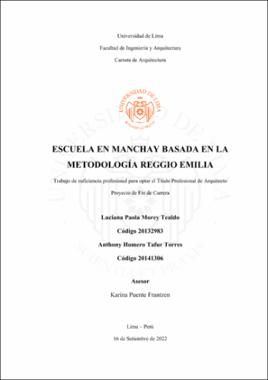Mostrar el registro sencillo del ítem
Escuela en Manchay Basada en la metodología Reggio Emilia
| dc.contributor.advisor | Puente Frantzen, Karina María | |
| dc.contributor.author | Morey Tealdo, Luciana Paola | |
| dc.contributor.author | Tafur Torres, Anthony Homero | |
| dc.date.accessioned | 2022-10-27T15:28:46Z | |
| dc.date.available | 2022-10-27T15:28:46Z | |
| dc.date.issued | 2022 | |
| dc.identifier.citation | Morey Tealdo L. y Tafur Torres, A. (2022). Escuela en Manchay Basada en la metodología Reggio Emilia [Trabajo de suficiencia profesional para optar el Título Profesional de Arquitecto, Universidad de Lima]. Repositorio Institucional de la Universidad de Lima. https://hdl.handle.net/20.500.12724/16786 | es_PE |
| dc.identifier.uri | https://hdl.handle.net/20.500.12724/16786 | |
| dc.description.abstract | Los colegios son los espacios más importantes en el desarrollo del ser humano. Pero durante mucho tiempo estas han sido diseñadas como fábricas y cuarteles en los cuales solo se buscaba implantar conocimiento de manera monótona y metódica, sin pensar en el principal usuario: el niño. El trabajo de suficiencia profesional busca generar un proyecto arquitectónico basado en la metodología Reggio Emilia con el objetivo de crear una arquitectura basada en el tercer maestro, en cual los recorridos dirijan a los niños a espacios donde el descubrimiento, la experimentación y la relación con el entorno se encuentren en todo momento. Para el trabajo, en primer lugar, investigamos el panorama histórico sobre la educación tanto en el mundo como en el Perú, para comprender y comparar la escuela tradicional y las nuevas metodologías. De igual manera, estudiamos la metodología Reggio Emilia a nivel mundial y a nivel nacional. Posteriormente, indagamos las teorías sobre el niño, el juego y el tercer maestro, las cuales tienen también un enfoque en la metodología Reggio Emilia. Por último, y luego de hacer un análisis sobre las necesidades y condiciones de Lima, analizamos la zona de Manchay, ubicado en el distrito de Pachacamac, lugar en el que se llevará a cabo el proyecto arquitectónico. El resultado plantea el rediseño del colegio existente de San Francisco de Asís, ubicado en Manchay y de educación básica regular, a fin de contribuir no solo en el tema educativo, sino también en poder integrar a la comunidad de Manchay. Para ello, y en base a la metodología Reggio Emilia, se toma como punto de partida la experiencia de los niños durante los recorridos. Esto nos lleva a pasar de las aulas en hilera a las células (aulas) independientes, lo que concluye en un módulo flexible lleno de posibilidades para la enseñanza escolar. | es_PE |
| dc.description.abstract | Schools are the most important spaces in the development of the human being. Yet for a long time, these have been designed as factories and barracks in which it was only sought to implement knowledge in a monotonous and methodical way, without thinking about the main user: the child. The work of professional sufficiency seeks to generate an architectural project based on the Reggio Emilia methodology with the objective of creating an architecture based on the third teacher, in which the routes lead children to spaces where discovery, experimentation and relationship with the environment are met at any time. For the project, we first researched the historical panorama of education both in the world and in Peru, in order to understand and compare traditional school and the new methodologies. Likewise, we studied the Reggio Emilia methodology at world and national level. Subsequently, we investigated the theories about the child, the game and the third teacher, which also have an approach on the Reggio Emilia methodology. Finally, after analyzing the needs and conditions of Lima, we analyzed the area of Manchay, located in the district of Pachacamac, where the architectural project will be executed. The result proposes the redesign of the existing school of San Francisco de Asis, located in Manchay and of regular basic education, in order to contribute not only in the educational area, but also to integrate the community of Manchay. For this purpose, and based on the Reggio Emilia methodology, we take as a starting point the experience of the children during the tours. This leads us to move from classrooms in rows to independent cells (classrooms), which results in a flexible module full of possibilities for school teaching. | en_EN |
| dc.format | application/pdf | |
| dc.language.iso | spa | |
| dc.publisher | Universidad de Lima | |
| dc.rights | info:eu-repo/semantics/openAccess | * |
| dc.rights.uri | https://creativecommons.org/licenses/by-nc-sa/4.0/ | * |
| dc.source | Repositorio Institucional - Ulima | |
| dc.source | Universidad de Lima | |
| dc.subject | Escuelas | es_PE |
| dc.subject | Edificios para la enseñanza | es_PE |
| dc.subject | Schools | en_EN |
| dc.subject | School buildings | en_EN |
| dc.title | Escuela en Manchay Basada en la metodología Reggio Emilia | es_PE |
| dc.title.alternative | School in Manchay based on the Reggio Emilia methodology | en_EN |
| dc.type | info:eu-repo/semantics/bachelorThesis | |
| thesis.degree.level | Título Profesional | es_PE |
| thesis.degree.discipline | Arquitectura | es_PE |
| thesis.degree.grantor | Universidad de Lima. Facultad de Ingeniería y Arquitectura | es_PE |
| dc.publisher.country | PE | |
| dc.type.other | Trabajo de suficiencia profesional | |
| thesis.degree.name | Arquitecto | es_PE |
| renati.discipline | 731026 | |
| dc.identifier.isni | 121541816 | |
| renati.author.dni | 76597439 | |
| renati.author.dni | 73186122 | |
| renati.level | https://purl.org/pe-repo/renati/level#tituloProfesional | * |
| renati.juror | Bonilla Di Tolla, Enrique | |
| renati.juror | Palacios Aguilar, José del Carmen | |
| renati.juror | Jones Pérez, Julian | |
| renati.type | https://purl.org/pe-repo/renati/type#trabajoDeSuficienciaProfesional | * |
| dc.subject.ocde | https://purl.org/pe-repo/ocde/ford#6.04.08 | |
| ulima.cat | OI |



